A Novel Approach to Quantitatively Account on Deposition Efficiency by Direct Energy Deposition: Case of Hardfacing-Coated AISI 304 SS
Abstract
1. Introduction
2. Materials and Methods
2.1. Samples Manufacturing
2.2. Surface Characterization
2.3. Material Distribution Index
2.4. Cross-Section Evaluation
2.5. Mechanical Perfomance
3. Results and Discussion
3.1. Powder Characterization
3.2. Coating Tracks Structural Characterization
3.2.1. Surface Geometrical Characterization
3.2.2. Material Distribution Index Analysis
- XY plane analysis (): the analysis of CSTs reveals that laser power (P) is the primary parameter influencing mean width. Specifically, increasing the power results in a larger melt pool, and vice versa. With regard to track stability and the ratio of material distribution on the XY plane, the analysis reveals a strong dependency of CST stability on scanning speed (V). Indeed, a higher scanning speed is always associated with a higher track perimeter and lower process stability. This phenomenon is visible in tracks characterized by lower laser power input; particularly, shows a clear decreasing trend in the material distribution index related to the XY plane as scanning speed is increased (see Table S1 and Figure 8). The same trend can also be observed for and conditions. However, this trend is less evident, since the increase in laser power ensures meltpool stability during the printing process by means of an increase in linear energy density input. conditions are characterized by a reverse trend that can be attributed to the interaction between laser and powder, as will be discussed in XZ plane analysis ().
- XZ plane analysis (): the analysis of profile asymmetry highlighted good stability in process parameters for most CSTs. A certain deviation has been observed for P06-F10 compared to the other conditions with the same laser power (). This behavior can be attributed to the insufficient linear energy density related to the F06-P10 condition. In particular, the laser power is not high enough to prevent the instability of molten metal fluid generated by the high scanning speed, which leads to Rayleigh-Plateau instability phenomena [55,56]. Various explanations can be attributed to the conditions of P10-Fn CSTs; as these conditions are characterized by higher laser power, phenomena such as recoil pressure [57,58] and particle disintegration [57] take precedence over process stability, resulting in extreme asymmetry of the CSTs. In particular, the combined effects of recoil pressure and powder evaporation, which are generated by an intense laser source, result in a smaller amount of material being added to the melt pool. Furthermore, the recoil pressure accelerates partially melted particles to such an extent that they are shredded into multiple spatters and deviated from their nominal trajectory by shearing forces, as can be seen in Figure 9a. Additionally, particles that reach the melt pool without being overheated, deviated, or shredded form an island of powder that starts rotating towards the left edge of the CST, pushed by the Marangoni effect [59], as shown in Figure 9b. This phenomenon was also highlighted by Prasad et al. [60]. These two behaviors, when combined, explain the total asymmetry of the CSTs generated with a laser power of 1000 W.
- YZ plane analysis (): the literature shows a certain dependency between the fluid depth and the Marangoni effect. In particular, it has been found that increasing the fluid film depth increases CST stability, since a greater depth is correlated with a more gradual gradient between different levels of viscosity and surface tension [61,62,63]. Consequently, CSTs with a higher deposited material value will exhibit a less pronounced Marangoni effect and fewer ripples on their surface [64]. Otherwise, it should be specified that this phenomenon is clearly visible only for conditions. Particularly, this behavior can be attributed to the increasing scanning speed at which a low amount of material is generated, and subsequently, more pronounced and recurring ripples appear. In the context of and conditions, the minimal material input at each evaluated scanning speed precluded the identification of discernible trend, since the bead thickness of the CST is insufficient to generate a noticeable change in viscosity and surface tension levels. Similarly, conditions are not characterized by a visible trend; it should be pointed out that for this set of process parameters, the main phenomena affecting scan track stability have already been discussed in the analysis of .
3.2.3. Surface Roughness Analysis
3.2.4. Cross Sections
3.2.5. Dilution and Clad Angle Analysis
3.3. Evaluation of Mechanical Properties Through Microhardness
4. Conclusions
- The maximum melting capacity of the laser with regard to Colmonoy 227-F powder is achieved under conditions that involve a laser power of 900 W. An increase in power is not beneficial in terms of material incorporated, evaluated as deposited normalized volume ();
- The use of the volume index as a standalone metric has proven inadequate in elucidating the comparative standing of DOE conditions. To address this issue, a new material distribution ratio has been developed and successfully employed along the XY, XZ, and YZ planes. The tracks exhibiting this ratio are P06-F04, P06-F06, P08-F04, P08-F06, P08-F08, P08-F10, P09-F04, P09-F06, and P09-F08. Of these, P09-F04 has been identified as the most suitable option for material distribution.
- The cross-section analysis reveals the fundamental metallurgical and morphological properties of the CSTs. SEM micrographs revealed that P06-F04 and P06-F06 are characterized by their high porosity, which is linked to a lower linear energy density, as defined by the DOE conditions. Conversely, no keyhole modes have been observed in DOE conditions involving high linear energy density. P10-F08 and P10-F10 cannot otherwise be considered compliant, as insufficient material is deposited on the build plate to define the generated CSTs as a coating. Regarding the analysis of favorable conditions relating to cross-section analysis (from P06-F08 to P10-F06), SEM revealed that increasing the laser power improves metallurgical bonding quality and substrate penetration.
- Microhardness and EDS maps revealed a gradual transition from pure Colmonoy 227-F (on the top part of the CSTs) to the pure AISI 304 substrate. This process enables gradual mechanical property attainment, from which superior static and fatigue mechanical performance can be derived compared to less homogeneous transitions.
Supplementary Materials
Author Contributions
Funding
Data Availability Statement
Acknowledgments
Conflicts of Interest
Abbreviations
| AM | Additive manufacturing |
| CAM | Computer-aided manufacturing |
| DED | Directed energy deposition |
| DOE | Design of experiment |
| CST | Coating scan track |
References
- Zhang, X.; Fu, W.; Lei, Z.; Wu, S.; Liang, J.; Li, B. Microstructure Evolution of the W-C Hard Coatings Using Directed Energy Deposition on Tungsten Alloy Surface. Surf. Coat. Technol. 2023, 470, 129827. [Google Scholar] [CrossRef]
- Raghavendra, S.; Amirabdollahian, S.; Perini, M.; Chemello, M.; Benedetti, M. Development of DED Process Parameters for Deposition of Bronze and Evaluation of Its Wear Properties under Dry Sliding Conditions. Procedia Struct. Integr. 2024, 53, 119–128. [Google Scholar] [CrossRef]
- Barragan, G.A.; Mariani, F.; Coelho, R.T. Application of 316L Stainless Steel Coating by Directed Energy Deposition Process. IOP Conf. Ser. Mater. Sci. Eng. 2021, 1154, 012014. [Google Scholar] [CrossRef]
- Ferguson, J.I.; MacDonald, E.; Thomas, B.J.; Sangid, M.D. The Role of Additively Manufactured Niobium Alloy C103 Substrate’s Surface Finish and Corner Geometry on the Silicide Diffusion Coating’s Performance. Surf. Coat. Technol. 2024, 479, 130510. [Google Scholar] [CrossRef]
- Yahalom, J. Corrosion Protection Methods. In Encyclopedia of Materials: Science and Technology; Elsevier: Oxford, UK, 2001. [Google Scholar]
- Duquette, D. Corrosion Control. In Encyclopedia of Materials: Science and Technology; Elsevier: Oxford, UK, 2006; pp. 1–7. [Google Scholar]
- Ielo, I.; Giacobello, F.; Sfameni, S.; Rando, G.; Galletta, M.; Trovato, V.; Rosace, G.; Plutino, M.R. Nanostructured Surface Finishing and Coatings: Functional Properties and Applications. Materials 2021, 14, 2733. [Google Scholar] [CrossRef]
- Svetlizky, A.; Das, M.; Zheng, B.; Vyatskikh, A.L.; Bose, S.; Bandyopadhyay, A.; Schoenung, J.M.; Lavernia, E.J.; Eliaz, N. Directed Energy Deposition (DED) Additive Manufacturing: Physical Characteristics, Defects, Challenges and Applications. Mater. Today 2021, 49, 271–295. [Google Scholar] [CrossRef]
- Zhu, I.; Xue, P.; Lan, Q.; Meng, G.; Ren, Y.; Yang, Z.; Xu, P.; Liu, Z. Recent Research and Development Status of Laser Cladding: A Review. Opt. Laser Technol. 2021, 138, 106915. [Google Scholar] [CrossRef]
- Errico, V.; Fusco, M.; Campanelli, S. Effect of DED Coating and DED + Laser Scanning on Surface Performance of L-PBF Stainless Steel Parts. Surf. Coat. Technol. 2022, 429, 127965. [Google Scholar] [CrossRef]
- Ji, C.; Zhou, R.; Vivegananthan, P.; Wu, M.S.; Gao, H.; Zhou, K. Recent Progress in Gradient-Structured Metals and Alloys. Prog. Mater. Sci. 2023, 140, 101194. [Google Scholar] [CrossRef]
- Ahn, D.-G. Directed Energy Deposition (DED) Process: State of the Art. Int. J. Precis. Eng. Manuf.-Green Technol. 2021, 8, 703–742. [Google Scholar] [CrossRef]
- Meng, L.; Sheng, P.; Zeng, X. Comparative Studies on the Ni60 Coatings Deposited by Conventional and Induction Heating Assisted Extreme-High-Speed Laser Cladding Technology: Formability, Microstructure and Hardness. J. Mater. Res. Technol. 2022, 16, 1732–1746. [Google Scholar] [CrossRef]
- Park, G.-W.; Shin, S.; Kim, J.-Y.; Koo, Y.-M.; Lee, W.; Lee, K.-A.; Park, S.S.; Jeon, J.B. Analysis of Solidification Microstructure and Cracking Mechanism of a Matrix High-Speed Steel Deposited Using Directed-Energy Deposition. J. Alloys Compd. 2022, 907, 164523. [Google Scholar] [CrossRef]
- Alimardani, M.; Toyserkani, E.; Huissoon, J.P.; Paul, C.P. On the Delamination and Crack Formation in a Thin Wall Fabricated Using Laser Solid Freeform Fabrication Process: An Experimental–Numerical Investigation. Opt. Lasers Eng. 2009, 47, 1160–1168. [Google Scholar] [CrossRef]
- Corbin, D.J.; Nassar, A.R.; Reutzel, E.W.; Beese, A.M.; Michaleris, P. Effect of Substrate Thickness and Preheating on the Distortion of Laser Deposited Ti–6Al–4V. J. Manuf. Sci. Eng. 2018, 140, 061009. [Google Scholar] [CrossRef]
- Li, C.; Liu, Z.Y.; Fang, X.; Guo, Y.B. Residual Stress in Metal Additive Manufacturing. Procedia CIRP 2018, 71, 348–353. [Google Scholar] [CrossRef]
- Denlinger, E.R.; Heigel, J.C.; Michaleris, P.; Palmer, T.A. Effect of Inter-Layer Dwell Time on Distortion and Residual Stress in Additive Manufacturing of Titanium and Nickel Alloys. J. Mater. Process. Technol. 2015, 215, 123–131. [Google Scholar] [CrossRef]
- Liu, Z.; Kim, H.; Liu, W.; Cong, W.; Jiang, Q.; Zhang, H. Influence of Energy Density on Macro/Micro Structures and Mechanical Properties of As-Deposited Inconel 718 Parts Fabricated by Laser Engineered Net Shaping. J. Manuf. Process. 2019, 42, 96–105. [Google Scholar] [CrossRef]
- Leung, C.L.A.; Marussi, S.; Towrie, M.; Atwood, R.C.; Withers, P.J.; Lee, P.D. The Effect of Powder Oxidation on Defect Formation in Laser Additive Manufacturing. Acta Mater. 2019, 166, 294–305. [Google Scholar] [CrossRef]
- Dass, A.; Moridi, A. State of the Art in Directed Energy Deposition: From Additive Manufacturing to Materials Design. Coatings 2019, 9, 418. [Google Scholar] [CrossRef]
- Mariani, F.E.; Konno, C.Y.N.; Cruz, C.B.; Lombardi, A.N.; Garcia, A.; Cheung, N.; Coelho, R.T.; Casteletti, L.C. Inconel 625 Coating Produced by Directed Energy Deposition–Laser Beam (DED-LB) for Corrosion-Resistant Applications. J. Mater. Eng. Perform. 2024; in press. [Google Scholar] [CrossRef]
- Pereira, J.C.; Irastorza, U.; Solana, A.; Soriano, C.; García, D.; Ruiz, J.E.; Lamikiz, A. Effect of Powder Reuse on Powder Characteristics and Properties of DED Laser Beam Metal Additive Manufacturing Process with Stellite® 21 and UNS S32750. Metals 2024, 14, 1031. [Google Scholar] [CrossRef]
- Li, S.; Chen, B.; Tan, C.; Song, X. Study on Recyclability of 316L Stainless Steel Powder by Using Laser Directed Energy Deposition. J. Mater. Eng. Perform. 2022, 31, 400–409. [Google Scholar] [CrossRef]
- Kiani, P.; Dupuy, A.D.; Ma, K.; Schoenung, J.M. The Reusability of AlSi10Mg Powder in Directed Energy Deposition. Powders 2024, 3, 28–43. [Google Scholar] [CrossRef]
- Patil, M.A.; Ghara, T.; Das, B.; Kulkarni, D.M. Influence of Cooling Rate on Microstructure, Dislocation Density, and Associated Hardness of Laser Direct Energy Deposited Inconel 718. Surf. Coat. Technol. 2025, 495, 131575. [Google Scholar] [CrossRef]
- Jeong, J.; Webster, S.; Liao, S.; Mogonye, J.-E.; Ehmann, K.; Cao, J. Cooling Rate Measurement in Directed Energy Deposition Using Photodiode-Based Planck Thermometry (PDPT). Addit. Manuf. Lett. 2022, 3, 100101. [Google Scholar] [CrossRef]
- Hemmati, I.; Ocelík, V.; De Hosson, J.T.M. Toughening Mechanism for Ni–Cr–B–Si–C Laser Deposited Coatings. Mater. Sci. Eng. A 2013, 582, 305–315. [Google Scholar] [CrossRef]
- Liu, L.; Wang, W.; Zhang, X.; Li, X.; Tian, Y.; Zhao, X. Microstructures and Mechanical Properties of Nb Nanoparticles Modified Ni60 Hard-Facing Alloy Fabricated by Laser Metal Deposition. Mater. Sci. Eng. A 2021, 814, 141238. [Google Scholar] [CrossRef]
- Yi, B.; Wang, J. Mechanism Clarification of Mitigating Welding Induced Buckling by Transient Thermal Tensioning Based on Inherent Strain Theory. J. Manuf. Process. 2021, 68, 1280–1294. [Google Scholar] [CrossRef]
- Pellizzari, M.; Zhao, Z.; Bosetti, P.; Perini, M. Optimizing Direct Laser Metal Deposition of H13 Cladding on CuBe Alloy Substrate. Surf. Coat. Technol. 2022, 432, 128084. [Google Scholar] [CrossRef]
- Rukhande, S.; Suryawanshi, S.; Bhosale, D.G.; Vasudev, H.; Khimasiya, R.; Das Gupta, R.; Deshmukh, I.; Wilson, F. High-Temperature Tribological Performance of Ni-Based Coating on 316L Stainless Steel. Results Surf. Interfaces 2025, 18, 100388. [Google Scholar] [CrossRef]
- Chakraborty, G.; Kumar, N.; Das, C.R.; Albert, S.K.; Bhaduri, A.K.; Dash, S.; Tyagi, A.K. Study on Microstructure and Wear Properties of Different Nickel Base Hardfacing Alloys Deposited on Austenitic Stainless Steel. Surf. Coat. Technol. 2014, 244, 180–188. [Google Scholar] [CrossRef]
- Kumar, K.P.; Mohanty, A.; Lingappa, M.S.; Srinath, M.S.; Panigrahi, S.K. Enhancement of Surface Properties of Austenitic Stainless Steel by Nickel Based Alloy Cladding Developed Using Microwave Energy Technique. Mater. Chem. Phys. 2020, 256, 123657. [Google Scholar] [CrossRef]
- Zhang, X.; Li, Z.; Yang, B.; Sun, X.; Sun, G.; Wang, S.; Chen, C. Microstructure and Mechanical Properties of 304 Stainless Steel Produced by Interpass Milling Hybrid Direct Energy Deposition-Arc. J. Mater. Res. Technol. 2023, 27, 3744–3756. [Google Scholar] [CrossRef]
- Singh, R.; Goel, S.; Verma, R.; Jayaganthan, R.; Kumar, A. Mechanical Behaviour of 304 Austenitic Stainless Steel Processed by Room Temperature Rolling. Mater. Today Proc. 2018, 330, 012017. [Google Scholar] [CrossRef]
- Pérez, H.; Vargas, G.; Magdaleno, C.; Silva, R. Oxy-Nitriding AISI 304 Stainless Steel by Plasma Electrolytic Surface Saturation to Increase Wear Resistance. Metals 2023, 13, 309. [Google Scholar] [CrossRef]
- Xiao, J.; Liu, Y.; Wang, J.; Tan, P.; Zhou, F. Enhanced Wear Resistance of 304 Stainless Steel by an Improved Method Based on Ultrasonic Strengthening Grinding Process and PTFE Coating. Constr. Build. Mater. 2024, 431, 136598. [Google Scholar] [CrossRef]
- Kaul, R.; Ganesh, P.; Albert, S.K.; Jaiswal, A.; Lalla, N.P.; Gupta, A.; Paul, C.P.; Nath, A.K. Laser Cladding of Austenitic Stainless Steel with Hardfacing Alloy Nickel Base. Surf. Eng. 2003, 19, 269–273. [Google Scholar] [CrossRef]
- Yan, J.; Yang, Z.; Zhang, L.; Wang, J. Research on the Microstructure and Properties of Arc-Sprayed Austenitic Stainless Steel and Nickel-Based Alloy Composite Coatings with Different Spraying Distances. Crystals 2025, 15, 142. [Google Scholar] [CrossRef]
- Silva, E.B.; Azevedo, M.G.; Matlakhova, L.A.; Oliveira, B.F.; Monteiro, S.N.; Oliveira, L.J. Influence of Pressure and Powder Characteristics on the Properties and Microstructure of Colmonoy-5 Alloy Sintered by Spark Plasma Sintering. J. Mater. Res. Technol. 2024, 31, 363–371. [Google Scholar] [CrossRef]
- Natarajan, J.; Yang, C.-H.; Karuppasamy, S.S. Investigation on Microstructure, Nanohardness and Corrosion Response of Laser Cladded Colmonoy-6 Particles on 316L Steel Substrate. Materials 2021, 14, 6183. [Google Scholar] [CrossRef]
- Hemmati, I.; Ocelík, V.; De Hosson, J.T.M. Effects of the Alloy Composition on Phase Constitution and Properties of Laser Deposited Ni-Cr-B-Si Coatings. Phys. Procedia 2013, 41, 302–311. [Google Scholar] [CrossRef]
- da Silva, L.J.; D’Oliveira, A.S.C.M. NiCrSiBC Alloy: Microstructure and Hardness of Coatings Processed by Arc and Laser. Weld. Int. 2017, 31, 1–8. [Google Scholar] [CrossRef]
- Bhoskar, A.; Naik, H.; Kalyankar, V.; Deshmukh, D. Nickel-Based Metallurgical Coating Architectures for Superior Wear Resistance in High-Temperature P91 Steel Applications. J. Alloys Met. Syst. 2025, 9, 100151. [Google Scholar] [CrossRef]
- Rukhande, S.W.; Rathod, W.S.; Bhosale, D.G. Ni-Based Coating Protection of 316L Stainless Steel at Dry, Elevated Temperature and Wet Sliding Condition. Mater. Today Proc. 2022, 62, 7415–7420. [Google Scholar] [CrossRef]
- Angelastro, A.; Campanelli, S.L.; Casalino, G. Statistical Analysis and Optimization of Direct Metal Laser Deposition of 227-F Colmonoy Nickel Alloy. Opt. Laser Technol. 2017, 94, 138–145. [Google Scholar] [CrossRef]
- Whip, B.; Sheridan, L.; Gockel, J. The Effect of Primary Processing Parameters on Surface Roughness in Laser Powder Bed Additive Manufacturing. Int. J. Adv. Manuf. Technol. 2019, 103, 4411–4422. [Google Scholar] [CrossRef]
- ISO 25178-1:2016; Geometrical Product Specifications (GPS)—Surface Texture: Areal—Part 1: Indication of Surface Texture. International Organization for Standardization: Geneva, Switzerland, 2016.
- Terek, P.; Kovačević, L.; Terek, V.; Bobić, Z.; Miletić, A.; Škorić, B.; Čekada, M.; Drnovšek, A. Surface Roughness and Its Effect on Adhesion and Tribological Performance of Magnetron Sputtered Nitride Coatings. Coatings 2024, 14, 1010. [Google Scholar] [CrossRef]
- Narasimharaju, S.R.; Liu, W.; Zeng, W.; See, T.L.; Scott, P.; Jiang, X.; Lou, S. Surface Texture Characterisation of Longitudinal and Latitudinal External and Internal Surfaces of Laser Powder Bed Fusion Processed Bespoke Ball Artefact. J. Manuf. Process. 2024, 116, 120–148. [Google Scholar] [CrossRef]
- Alya, S.; Vundru, C.; Ankamreddy, B.; Singh, R. Characterization and Modeling of Deposition Geometry in Directed Energy Deposition over Inclined Surfaces. Procedia Manuf. 2019, 34, 695–703. [Google Scholar] [CrossRef]
- Gandhi, D.; Mukherjee, M.; Rajak, B.; Arora, K.S. Directed Energy Deposition (DED) of Fe-6.5wt%Si Electrical Steel. Prog. Addit. Manuf. 2025; in press. [Google Scholar] [CrossRef]
- ISO 4545-1:2017; Metallic Materials—Knoop Hardness Test—Part 1: Test Method. International Organization for Standardization: Geneva, Switzerland, 2017.
- Miranda-Lugo, P.J.; Rodriguez, O.M.H. Plateau–Rayleigh Instability in Low-Viscosity Ratio Stratified Liquid–Liquid Flow. Int. J. Multiph. Flow 2025, 189, 105253. [Google Scholar] [CrossRef]
- Zang, W.; Hou, W.; Deike, L.; Arnold, C. Understanding the Rayleigh Instability in Humping Phenomenon during Laser Powder Bed Fusion Process. Int. J. Extrem. Manuf. 2022, 4, 015201. [Google Scholar] [CrossRef]
- Da Silva, A.; Volpp, J.; Kaplan, A.F.H. The Effects of Laser Irradiation on an Aluminium Powder Stream in Directed Energy Deposition. Addit. Manuf. 2021, 41, 101968. [Google Scholar] [CrossRef]
- Lv, C.; Wang, J.; Li, H.; Yin, Q.; Liu, W.; Shen, S. Dynamics of the Laser–Powder Interaction in the Ti6Al4V Powder Feeding Process of Laser-Directed Energy Deposition Additive Manufacturing. J. Mater. Res. Technol. 2023, 27, 6376–6385. [Google Scholar] [CrossRef]
- Lei, C.; Ren, S.; Yin, C.; Liu, X.; Chen, M.; Wu, J.; Han, C. Manipulating Melt Pool Thermofluidic Transport in Directed Energy Deposition Driven by a Laser Intensity Spatial Shaping Strategy. Virt. Phys. Prototyp. 2024, 19, e2308513. [Google Scholar] [CrossRef]
- Prasad, H.S.; Brueckner, F.; Kaplan, A.F.H. Powder Incorporation and Spatter Formation in High Deposition Rate Blown Powder Directed Energy Deposition. Addit. Manuf. 2020, 35, 101413. [Google Scholar] [CrossRef]
- Iasella, S.V.; Sun, N.; Zhang, X.; Corcoran, T.E.; Garoff, S.; Przybycien, T.M.; Tilton, R.D. Flow Regime Transitions and Effects on Solute Transport in Surfactant-Driven Marangoni Flows. J. Colloid Interface Sci. 2019, 553, 136–147. [Google Scholar] [CrossRef]
- Zhang, K.; Chen, Y.; Marussi, S.; Fan, X.; Fitzpatrick, M.; Bhagavath, S.; Majkut, M.; Lukic, B.; Jakata, K.; Rack, A.; et al. Pore Evolution Mechanisms during Directed Energy Deposition Additive Manufacturing. Nat. Commun. 2024, 15, 1715. [Google Scholar] [CrossRef] [PubMed]
- Zhang, S.; Yao, C.; Zhang, D.; Liu, W.; He, L.; Du, D.; Sun, B.; Dong, A.; Zhang, B.; Xiong, L. Dynamics of Pore Formation and Evolution during Multi-Layer Directed Energy Deposition Additive Manufacturing via In-Situ Synchrotron X-ray Imaging: A Case Study on High-Entropy Cantor Alloy. Int. J. Mach. Tools Manuf. 2024, 200, 104181. [Google Scholar] [CrossRef]
- Wang, J.; Zhu, R.; Liu, Y.; Zhang, L. Understanding Melt Pool Characteristics in Laser Powder Bed Fusion: An Overview of Single- and Multi-Track Melt Pools for Process Optimization. Adv. Powder Mater. 2023, 2, 100137. [Google Scholar] [CrossRef]
- Ertay, D.S.; Naiel, M.A.; Vlasea, M.; Fieguth, P. Process Performance Evaluation and Classification via In-Situ Melt Pool Monitoring in Directed Energy Deposition. CIRP J. Manuf. Sci. Technol. 2021, 35, 298–314. [Google Scholar] [CrossRef]
- An, Z.; Sun, H.; Zhang, X. Bead Geometry Prediction for Gas Metal Arc Directed Energy Deposited Layer Using Interpretable Machine Learning. Mater. Today Commun. 2025, 42, 111138. [Google Scholar] [CrossRef]
- Templeton, W.F.; Hinnebusch, S.; Strayer, S.T.; To, A.C.; Pistorius, P.C.; Narra, S.P. A Mechanistic Explanation of Shrinkage Porosity in Laser Powder Bed Fusion Additive Manufacturing. Acta Mater. 2024, 266, 119632. [Google Scholar] [CrossRef]
- Kurz, F.D.; Mahamood, R.M. Fundamentals of Solidification; Trans Tech Publications Ltd: Bäch, Switzerland, 2023. [Google Scholar]
- Chandra, S.; Radhakrishnan, J.; Huang, S.; Wei, S.; Ramamurty, U. Solidification in metal additive manufacturing: Challenges, solutions, and opportunities. Prog. Mater. Sci. 2025, 148, 101361. [Google Scholar] [CrossRef]
- Khalajzadeh, V.; Beckermann, C. Simulation of Shrinkage Porosity Formation During Alloy Solidification. Metall. Mater. Trans. A 2020, 51, 2239–2254. [Google Scholar] [CrossRef]
- Alimohammadi, A.; Khorram, A.; Araee, A. Statistical Modeling and Optimization of Clad Geometry in Laser Cladding of Amdry 365 on Hastelloy X Superalloy with Response Surface Methodology. Vacuum 2024, 230, 113665. [Google Scholar] [CrossRef]
- Xiang, D.; Wang, D.; Wang, S.; Yan, L.; Chen, Y. Analysis and Optimization of Laser Cladding Ti-B4C Composite Coatings Based on the Interaction and GABP-NSGAII Algorithm. Surf. Coat. Technol. 2024, 493, 131186. [Google Scholar] [CrossRef]
- Shu, L.; Shi, J.; Huang, T.; Li, P.; Wu, H.; Zhou, J. Optimization of Laser Cladding Powder Ratio and Process Parameters Based on MOGWO Algorithm. Mater. Today Commun. 2024, 41, 110605. [Google Scholar] [CrossRef]
- Gao, S.; Fu, Q.; Li, M.; Huang, L.; Liu, N.; Cui, C.; Yang, B.; Zhang, G. Optimization of Laser Cladding Parameters for High-Entropy Alloy-Reinforced 316L Stainless-Steel via Grey Relational Analysis. Coatings 2024, 14, 1103. [Google Scholar] [CrossRef]
- Momeni, S.; Coelho, R.T.; Nuñez, J.G.; Jasinevicius, R.G. Effect of Process Parameters on the Geometry of Single-Track Deposits of Inconel 718 onto AISI4140 Using Laser Cladding. Int. J. Adv. Manuf. Technol. 2024, 134, 5337–5353. [Google Scholar] [CrossRef]
- Pekkarinen, J.; Kujanpää, V.; Salminen, A. Laser Cladding with Scanning Optics: Effect of Power Adjustment. J. Laser Appl. 2012, 24, 032003. [Google Scholar] [CrossRef]
- Mahamood, R.M.; Akinlabi, E.T.; Owolabi, M.G. Effect of Laser Power and Powder Flow Rate on Dilution Rate and Surface Finish Produced During Laser Metal Deposition of Titanium Alloy. In Proceedings of the 8th International Conference on Mechanical and Intelligent Manufacturing Technologies (ICMIMT), Cape Town, South Africa, 3–6 February 2017; pp. 6–10. [Google Scholar] [CrossRef]
- Zhu, S.; Chen, W.; Zhan, X.; Ding, L.; Wang, E. Optimization of Dilution Rate of Laser Cladding Repair Based on Deep Learning. Int. J. Adv. Manuf. Technol. 2020, 110, 1471–1484. [Google Scholar] [CrossRef]
- Carrozza, A.; Mazzucato, F.; Aversa, A.; Lombardi, M.; Bondioli, F.; Biamino, S.; Valente, A.; Fino, P. Single Scans of Ti-6Al-4V by Directed Energy Deposition: A Cost and Time Effective Methodology to Assess the Proper Process Window. Metals Mater. Int. 2021, 27, 3590–3602. [Google Scholar] [CrossRef]
- Wang, Y.; Yu, T.; Zhang, Y.; Sun, J.; Sun, Z. Process Parameter Optimization of Fe-Based Coating on Ductile Iron Using Laser Cladding with Grey Related Analysis. Opt. Laser Technol. 2025, 181, 111906. [Google Scholar] [CrossRef]
- Belsvik, M.A.; Hansen, V. Process Parameter Optimization for Directed Laser Deposition of Hot Work Tool Steel Dievar. Int. J. Adv. Manuf. Technol. 2025, 138, 1129–1142. [Google Scholar] [CrossRef]
- Abioye, T.E.; McCartney, D.G.; Clare, A.T. Laser Cladding of Inconel 625 Wire for Corrosion Protection. J. Mater. Process. Technol. 2015, 217, 232–240. [Google Scholar] [CrossRef]
- Kim, J.-D.; Lee, E.-J.; Wang, J.-G. Comparison of Clad Layer Characteristics with Overlapping Criterion in Multi Pass Laser Cladding. J. Korean Soc. Mar. Eng. 2016, 40, 768–773. [Google Scholar] [CrossRef]
- Xiong, J.; Zhang, G.; Gao, H.; Wu, L. Modeling of Bead Section Profile and Overlapping Beads with Experimental Validation for Robotic GMAW-Based Rapid Manufacturing. Robot. Comput.-Integr. Manuf. 2013, 29, 417–423. [Google Scholar] [CrossRef]
- Zhong, C.; Liu, P.; Ren, X.; Luan, B.; Volinsky, A.A. Effect of Inconel 625 Coating via High-Speed Laser Direct Energy Deposition on the Fatigue Characteristics of Q235 Steel. Int. J. Fatigue 2025, 193, 108746. [Google Scholar] [CrossRef]
- La Barbera-Sosa, J.G.; Santana, Y.Y.; Villalobos-Gutiérrez, C.; Chicot, D.; Lesage, J.; Decoopman, X.; Iost, A.; Staia, M.H.; Puchi-Cabrera, E.S. Fatigue Behavior of a Structural Steel Coated with a WC–10Co–4Cr/Colmonoy 88 Deposit by HVOF Thermal Spraying. Surf. Coat. Technol. 2013, 220, 248–256. [Google Scholar] [CrossRef][Green Version]
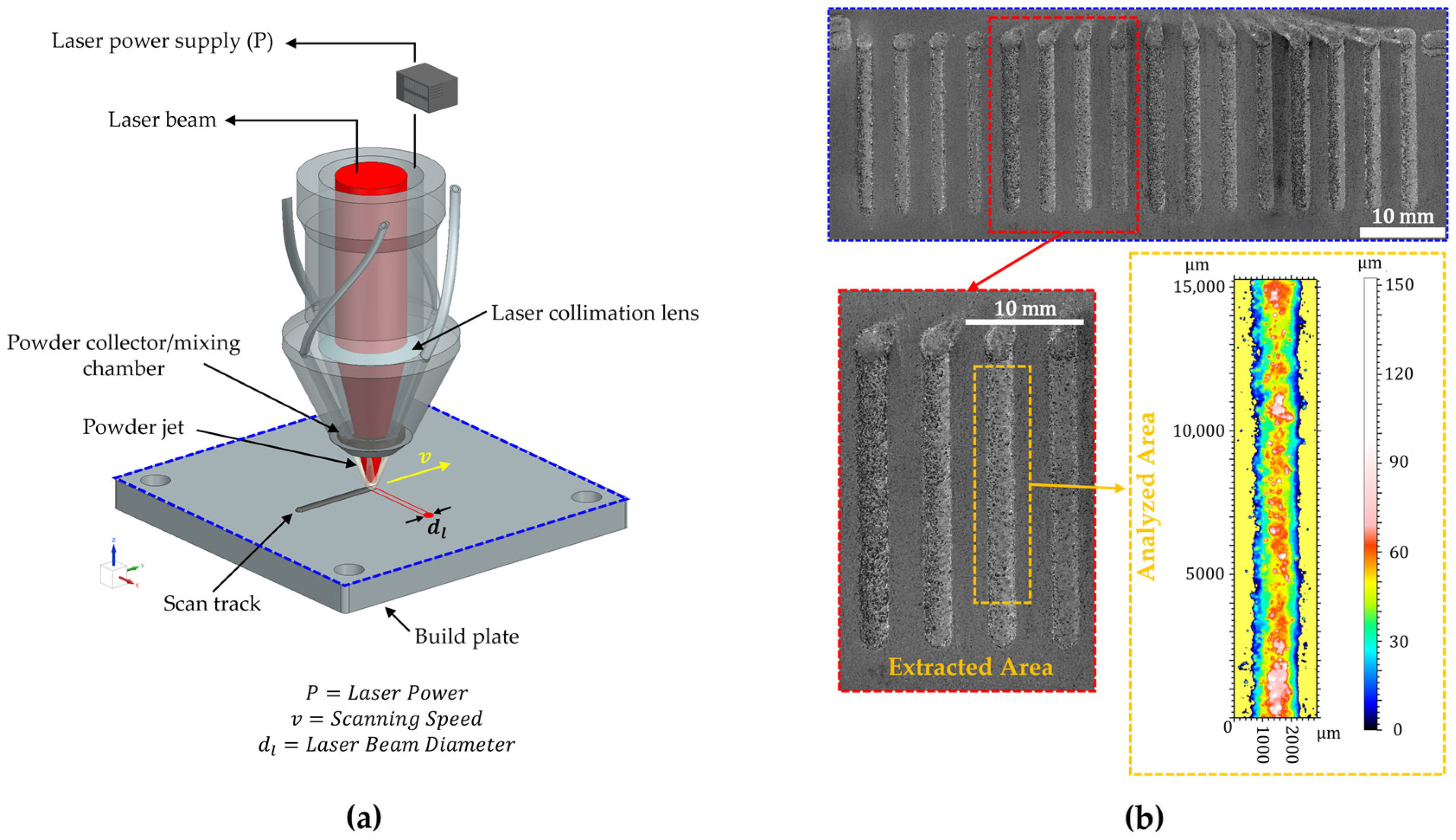
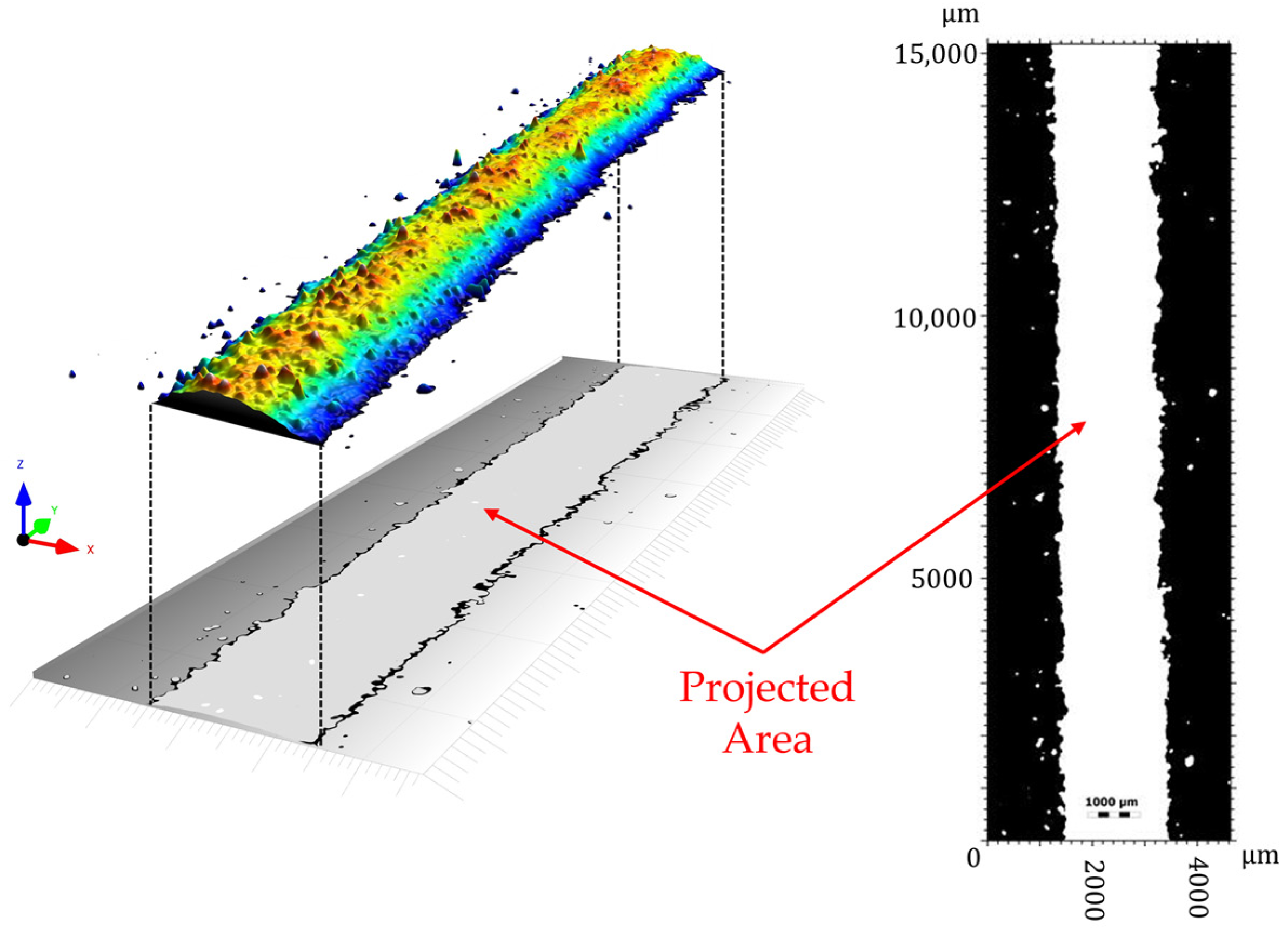
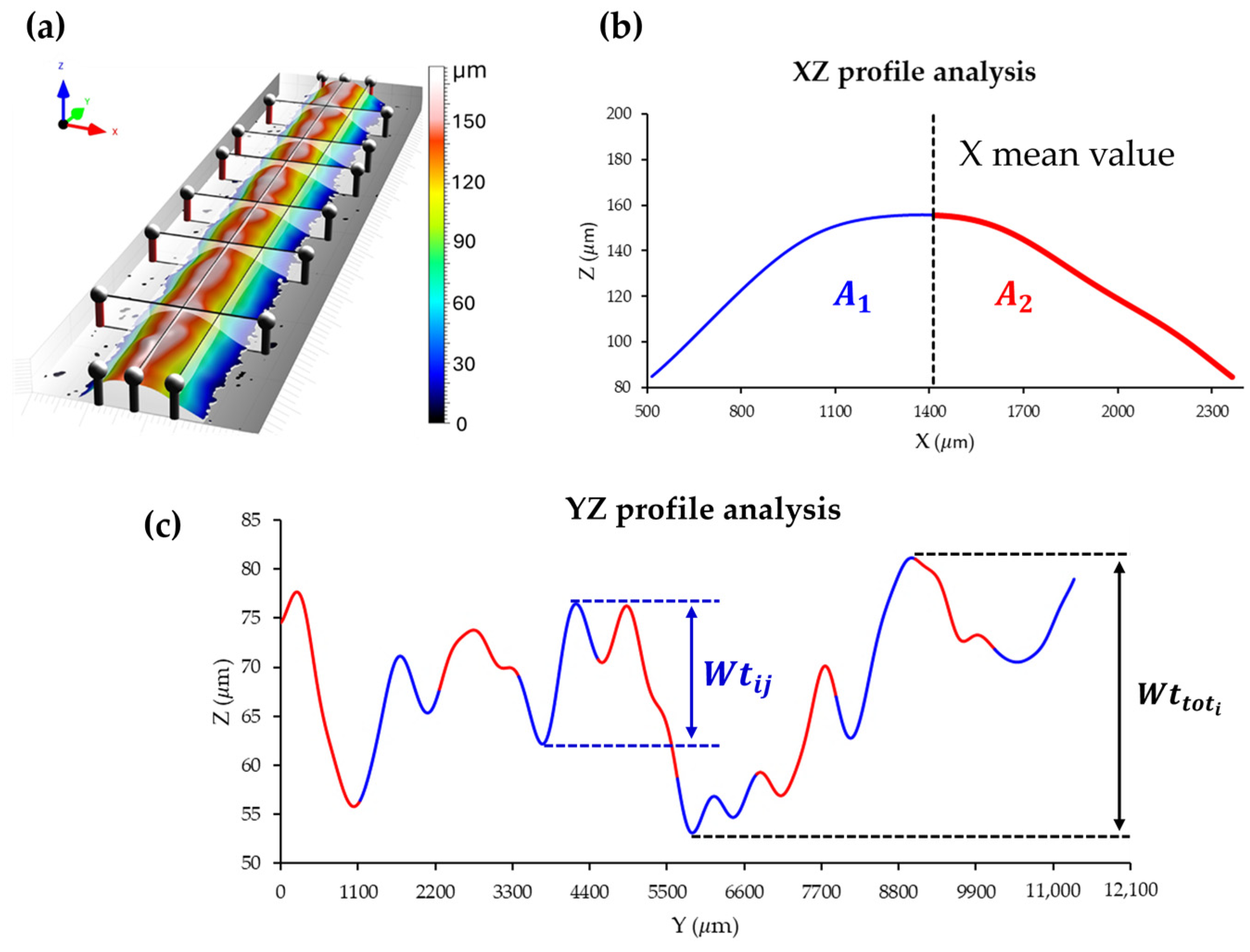
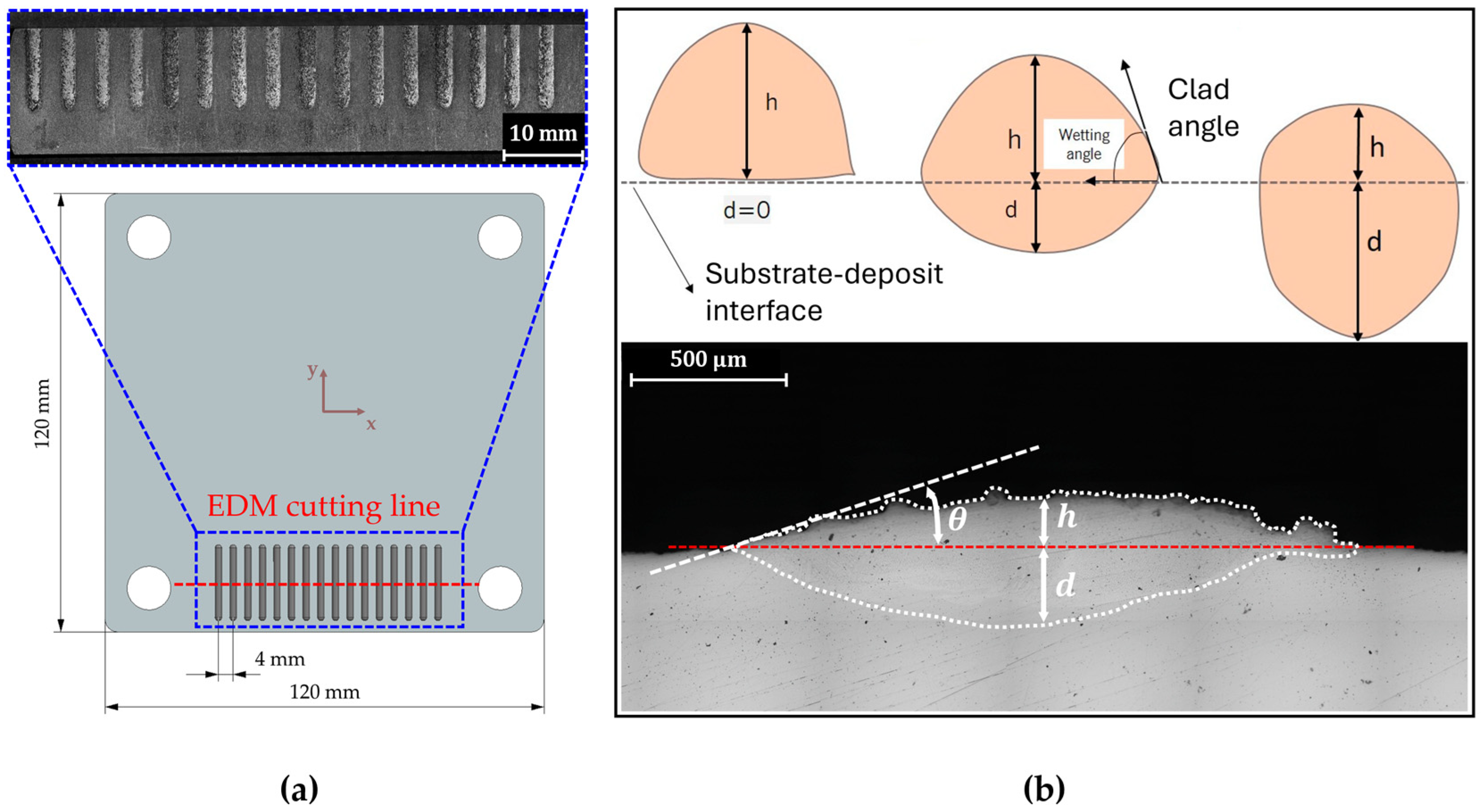
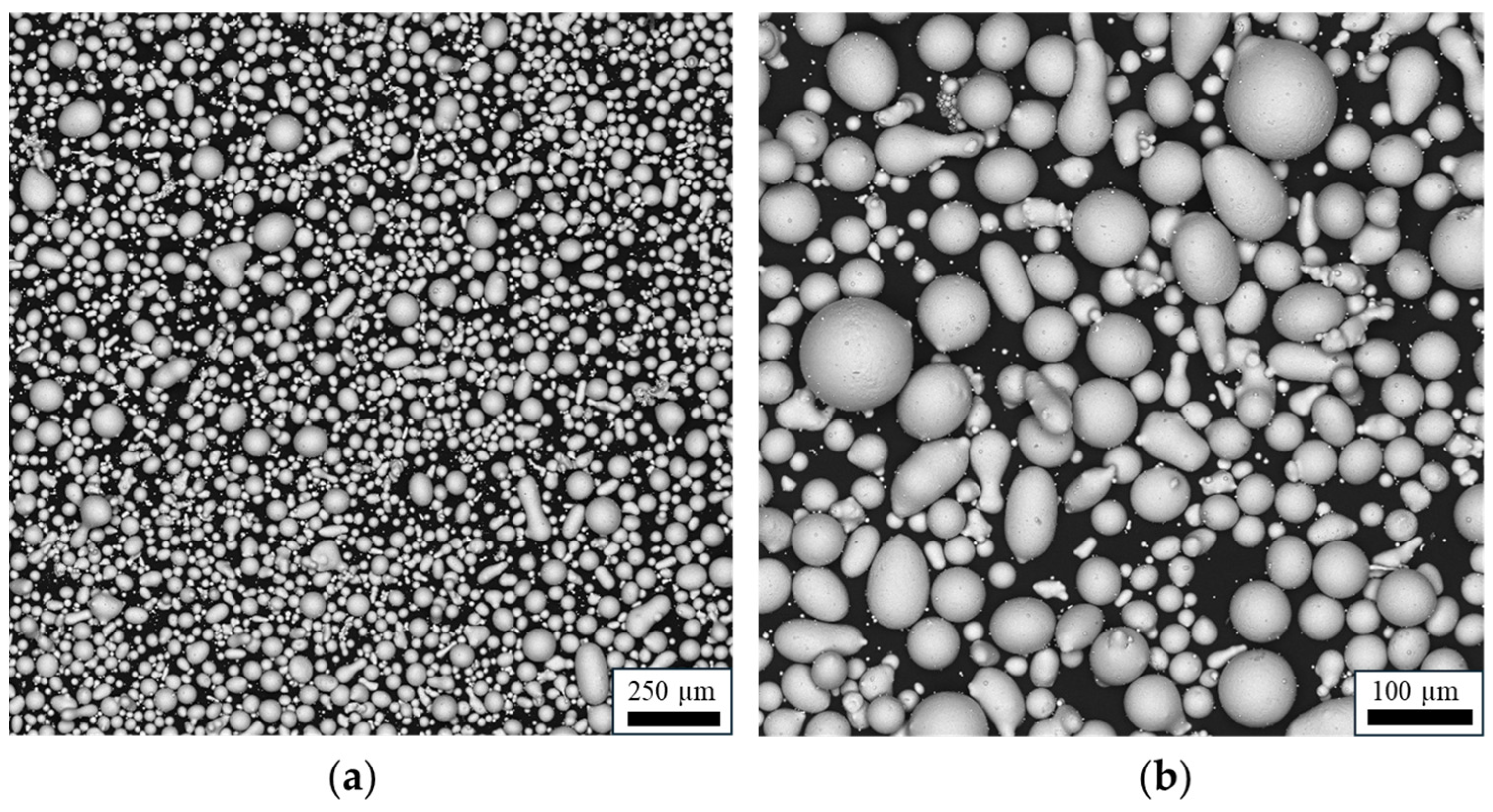
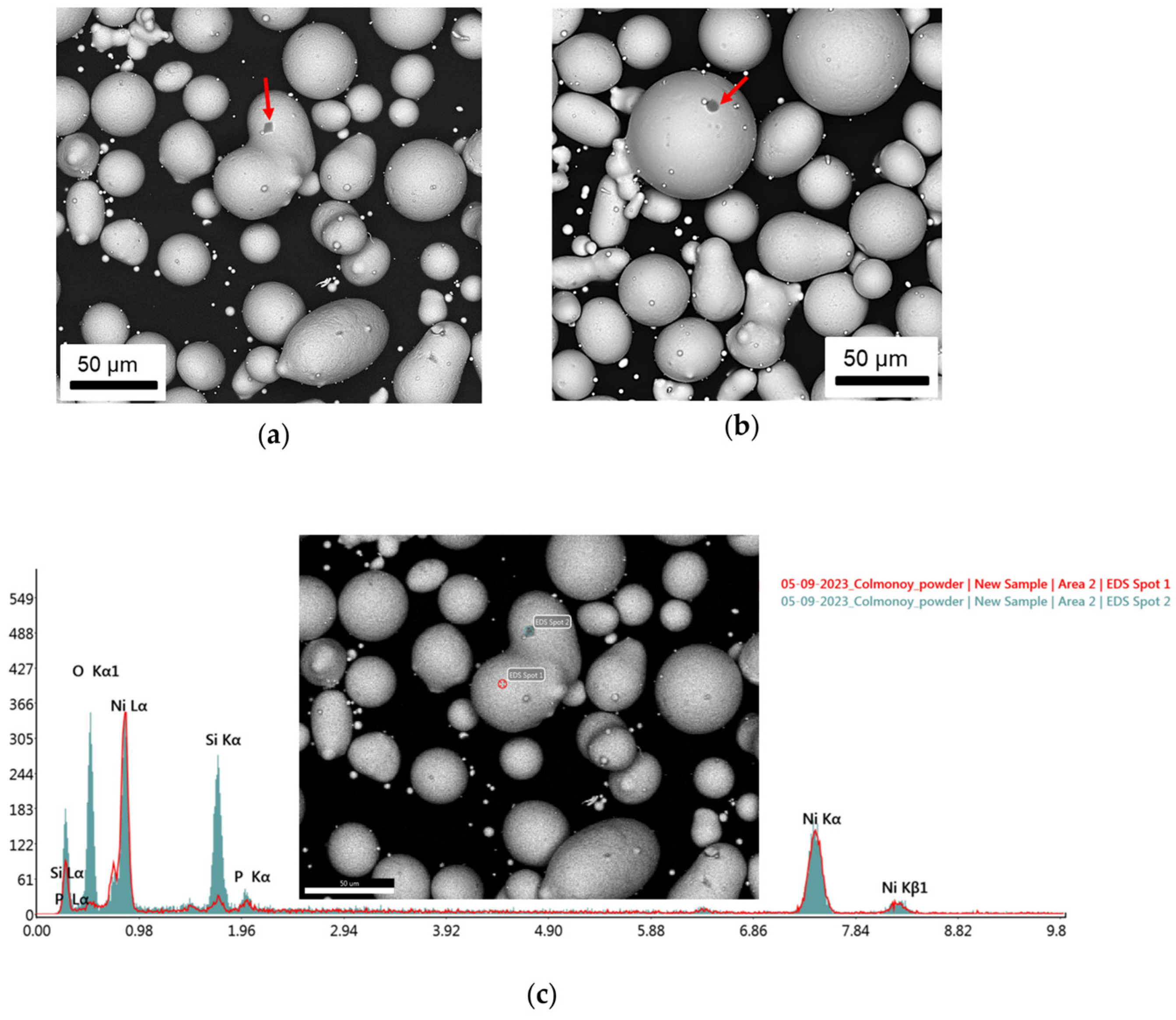

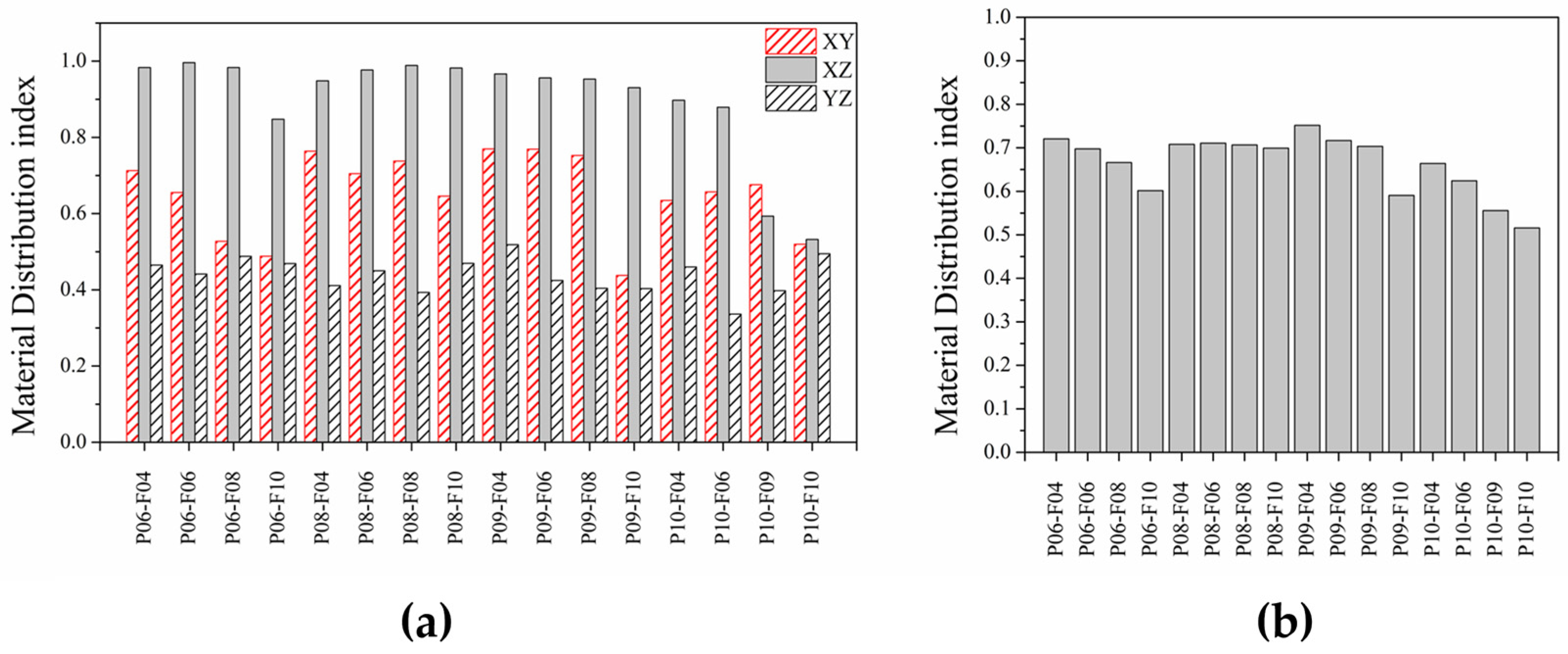
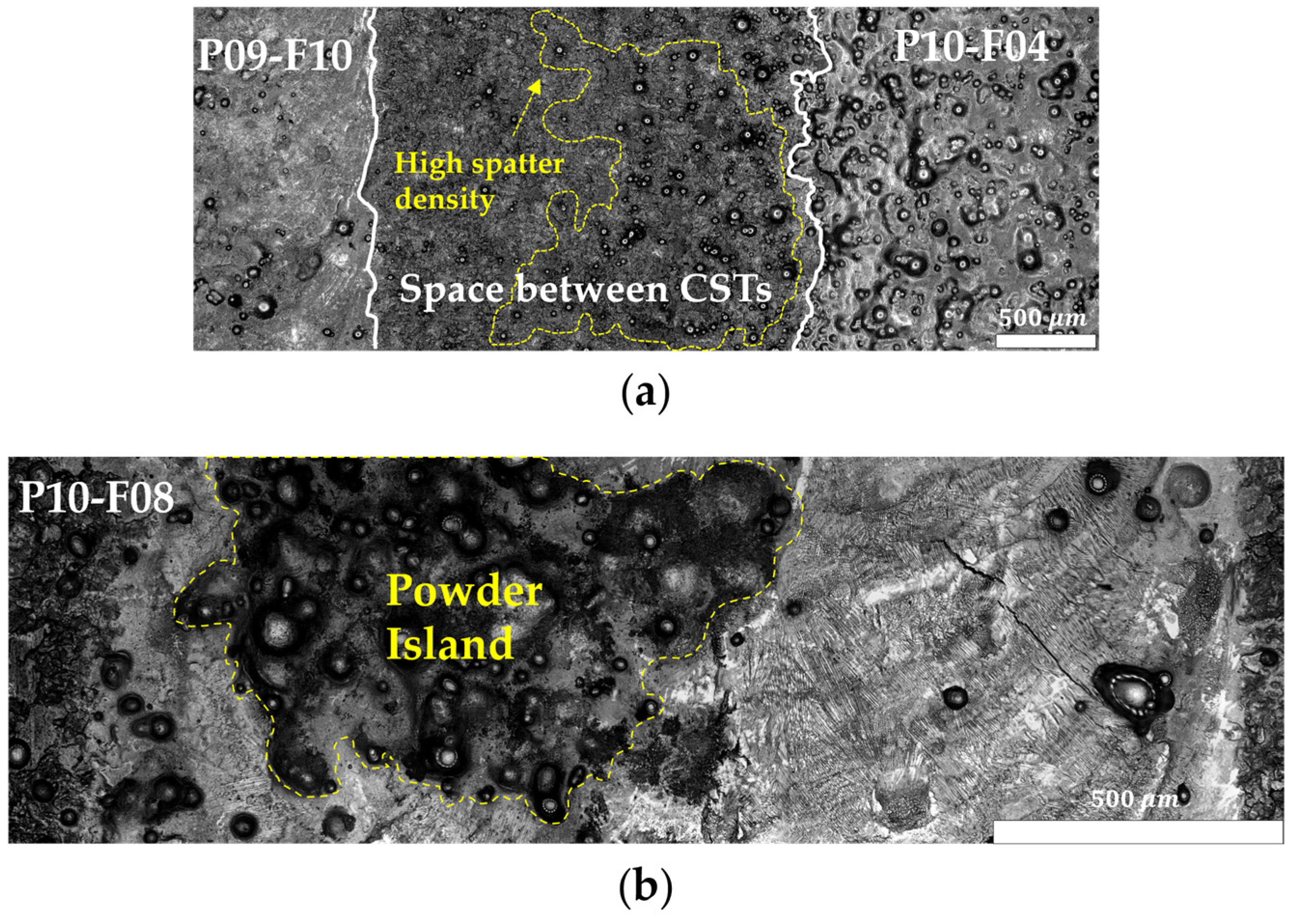



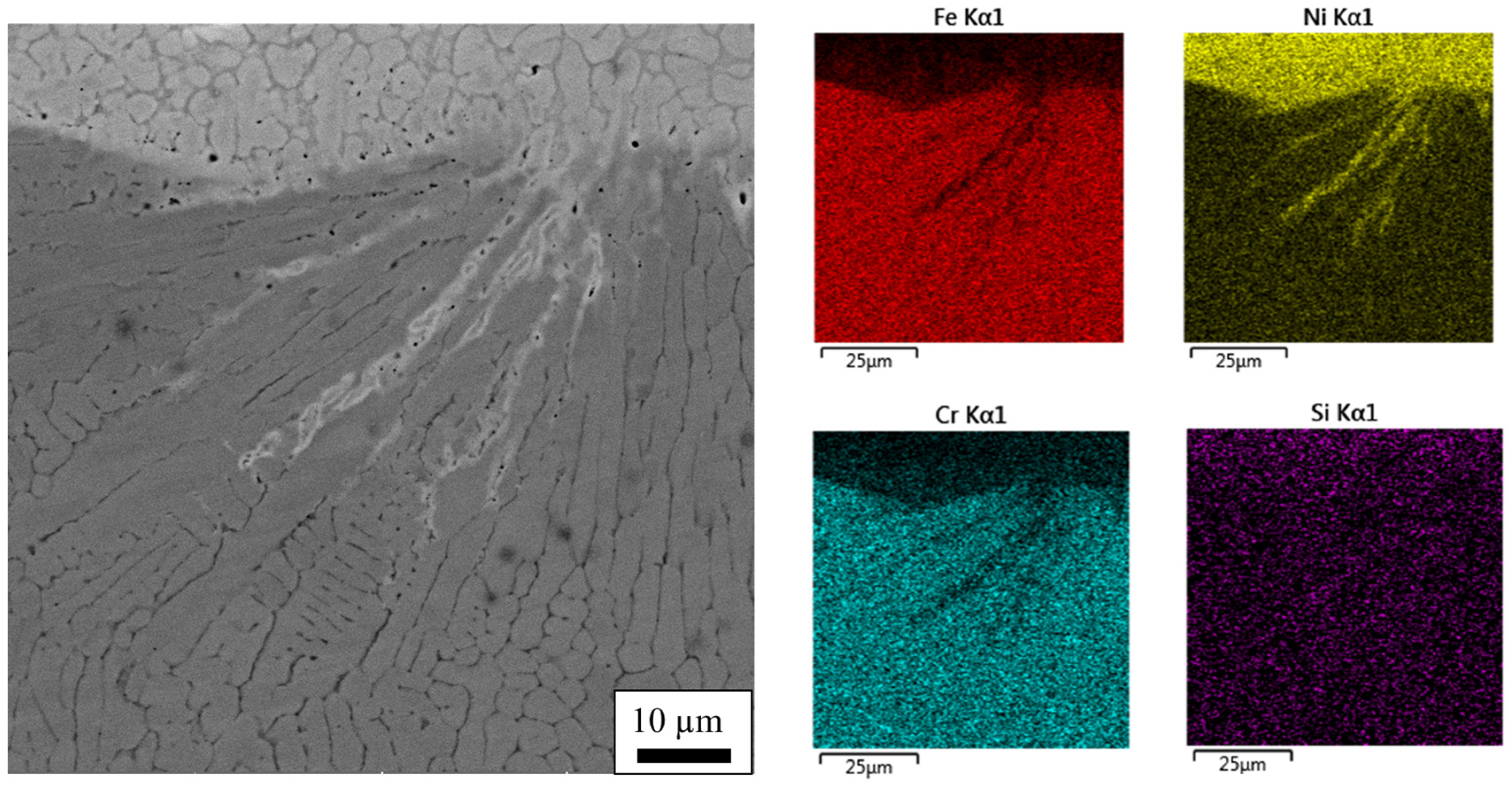

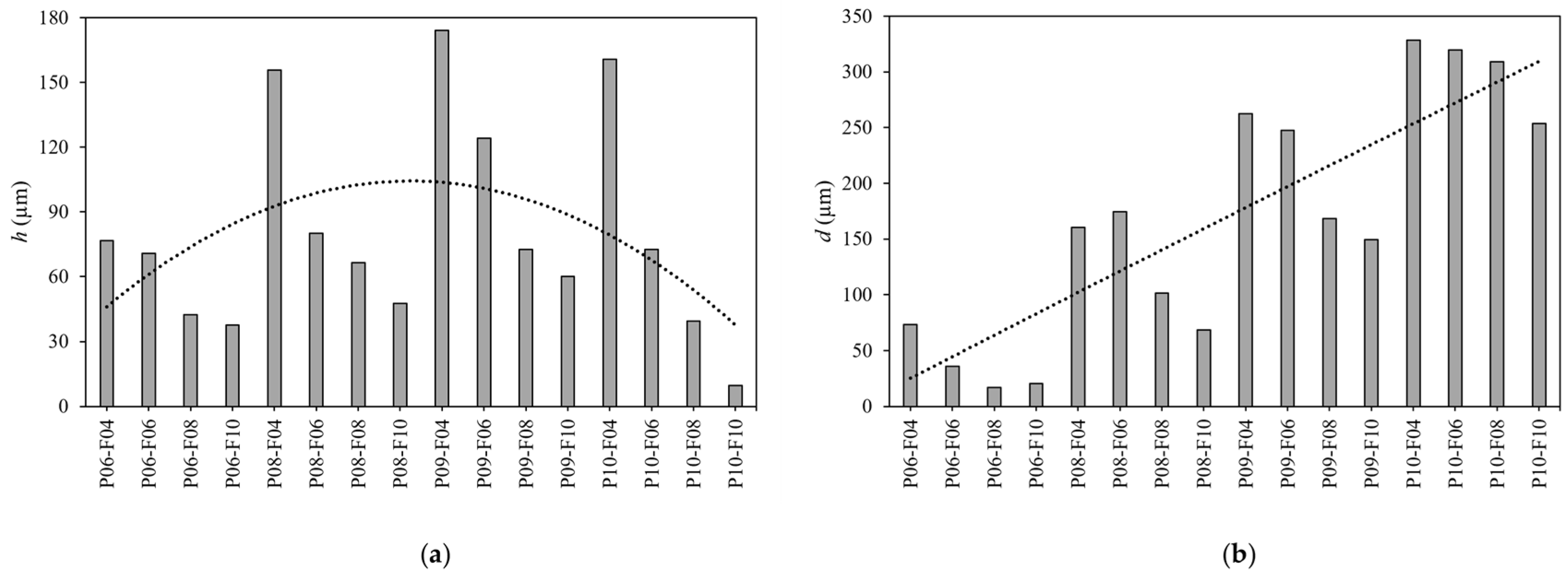
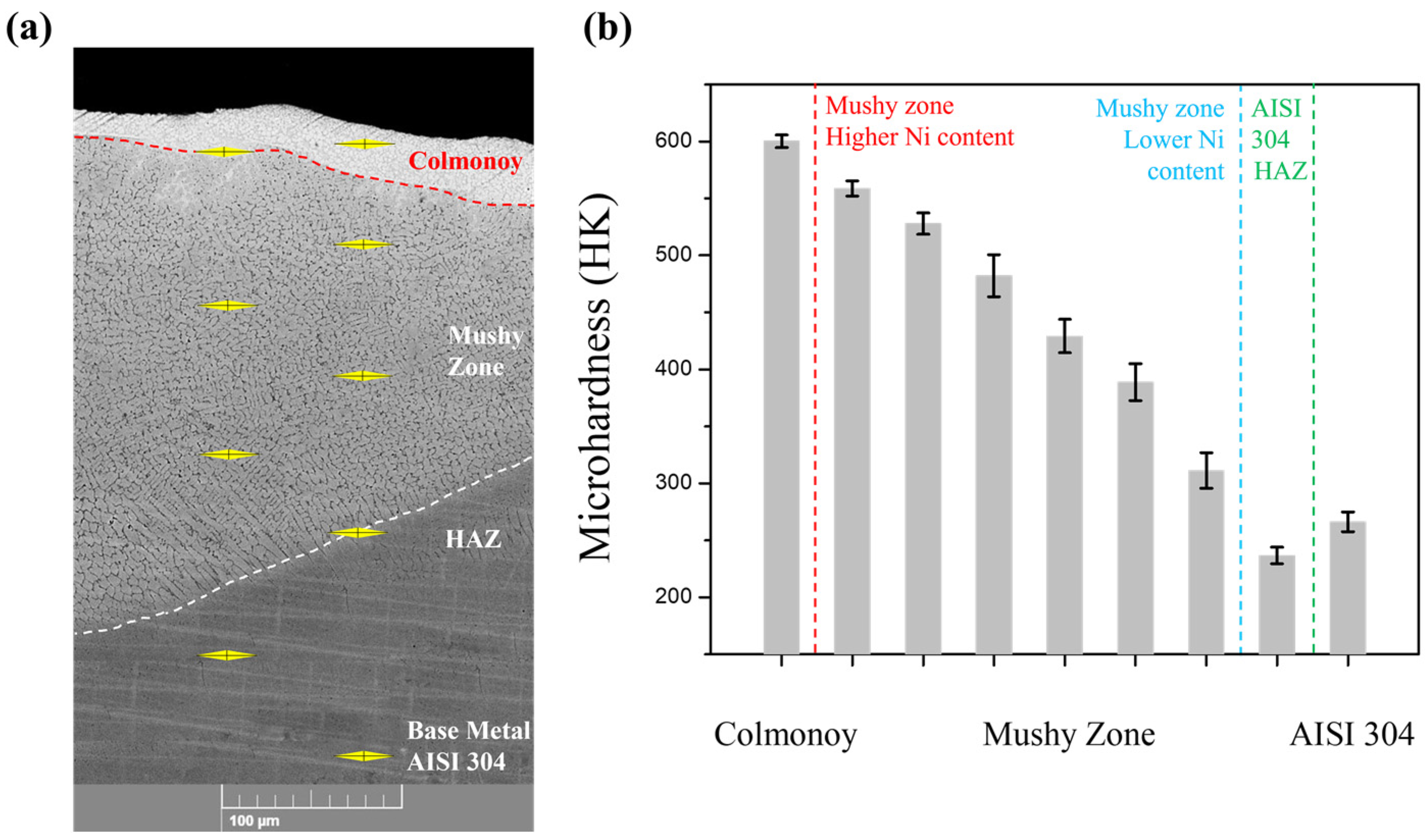
| Element | B | C | Co | Cr | Fe | Mn | N | Ni | P | S | Si | Other |
|---|---|---|---|---|---|---|---|---|---|---|---|---|
| Colmonoy 227-F (wt.%) | 0.93 | 0.02 | ≤0.01 | 0.11 | 0.05 | - | - | Bal. | 2 | - | 0.07 | |
| AISI 304 (wt.%) | - | 0.07 | - | 17.5–19.5 | Bal. | ≤2 | ≤0.11 | 8.0–10.5 | ≤0.045 | ≤0.03 | ≤1 | - |
| DOE | Sample ID Pn-Fm | Laser Power (W) | Scanning Speed (mm/min) |
|---|---|---|---|
| 1 | P06-F04 | 600 | 400 |
| 2 | P06-F06 | 600 | 600 |
| 3 | P06-F08 | 600 | 800 |
| 4 | P06-F10 | 600 | 1000 |
| 5 | P08-F04 | 800 | 400 |
| 6 | P08-F06 | 800 | 600 |
| 7 | P08-F08 | 800 | 800 |
| 8 | P08-F10 | 800 | 1000 |
| 9 | P09-F04 | 900 | 400 |
| 10 | P09-F06 | 900 | 600 |
| 11 | P09-F08 | 900 | 800 |
| 12 | P09-F10 | 900 | 1000 |
| 13 | P10-F04 | 1000 | 400 |
| 14 | P10-F06 | 1000 | 600 |
| 15 | P10-F08 | 1000 | 800 |
| 16 | P10-F10 | 1000 | 1000 |
| Si (wt%) | P (wt%) | Fe (wt%) | Ni (wt%) | |
|---|---|---|---|---|
| Experimental | 1.4 ± 0.1 | 1.02 ± 0.08 | 1.9 ± 0.1 | Balance |
| Nominal (Wall-Colmonoy) | 2.74 | 2 | 0.05 | Balance |
| # | Fe (wt%) | Ni (wt%) | Cr (wt%) | Si (wt%) | P (wt%) |
|---|---|---|---|---|---|
| 1 | 78.62 ± 0.17 | NA | 20.93 ± 0.15 | 0.45 ± 0.08 | NA |
| 2 | 57.21 ± 0.37 | 25.21 ± 0.25 | 16.48 ± 0.16 | 0.94 ± 0.09 | 0.52 ± 0.08 |
| 3 | 46.03 ± 0.30 | 39.54 ± 0.27 | 17.10 ± 0.13 | 1.55 ± 0.10 | 1.11 ± 0.09 |
| 4 | 13.23 ± 0.14 | 79.69 ± 0.30 | 3.57 ± 0.09 | 1.95 ± 0.11 | 1.51 ± 0.10 |
Disclaimer/Publisher’s Note: The statements, opinions and data contained in all publications are solely those of the individual author(s) and contributor(s) and not of MDPI and/or the editor(s). MDPI and/or the editor(s) disclaim responsibility for any injury to people or property resulting from any ideas, methods, instructions or products referred to in the content. |
© 2025 by the authors. Licensee MDPI, Basel, Switzerland. This article is an open access article distributed under the terms and conditions of the Creative Commons Attribution (CC BY) license (https://creativecommons.org/licenses/by/4.0/).
Share and Cite
Grima, G.; Sleem, K.; Santoni, A.; Virgili, G.; Foti, V.; Cabibbo, M.; Santecchia, E. A Novel Approach to Quantitatively Account on Deposition Efficiency by Direct Energy Deposition: Case of Hardfacing-Coated AISI 304 SS. Crystals 2025, 15, 626. https://doi.org/10.3390/cryst15070626
Grima G, Sleem K, Santoni A, Virgili G, Foti V, Cabibbo M, Santecchia E. A Novel Approach to Quantitatively Account on Deposition Efficiency by Direct Energy Deposition: Case of Hardfacing-Coated AISI 304 SS. Crystals. 2025; 15(7):626. https://doi.org/10.3390/cryst15070626
Chicago/Turabian StyleGrima, Gabriele, Kamal Sleem, Alberto Santoni, Gianni Virgili, Vincenzo Foti, Marcello Cabibbo, and Eleonora Santecchia. 2025. "A Novel Approach to Quantitatively Account on Deposition Efficiency by Direct Energy Deposition: Case of Hardfacing-Coated AISI 304 SS" Crystals 15, no. 7: 626. https://doi.org/10.3390/cryst15070626
APA StyleGrima, G., Sleem, K., Santoni, A., Virgili, G., Foti, V., Cabibbo, M., & Santecchia, E. (2025). A Novel Approach to Quantitatively Account on Deposition Efficiency by Direct Energy Deposition: Case of Hardfacing-Coated AISI 304 SS. Crystals, 15(7), 626. https://doi.org/10.3390/cryst15070626









